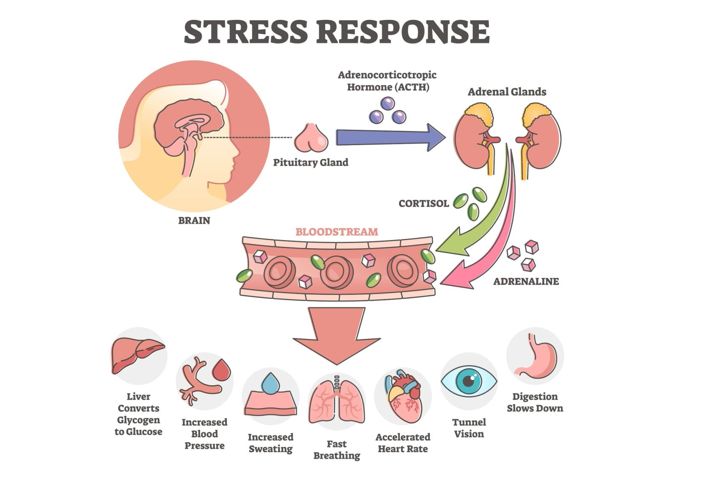Anxiety is a natural reaction that makes us aware of possible dangers. The symptoms typically subside when we realize we are not in danger.For some people, though, anxiety is harder to manage. Worries about hypothetical danger persist, and the brain stays in an alert state, even when there is no immediate threat. Trait anxiety is when anxiety is a stable personality feature instead of a passing reaction to dangerous circumstances.
Trait and State Anxiety
State and trait anxiety have many overlapping symptoms, but they are two different conditions. State anxiety is a passing but intense emotional state resulting from real or perceived danger. It is not linked to any specific conditions or diseases.Trait anxiety is the tendency to respond to various situations with the same intense emotions, including minor concerns and worries. Researchers believe that trait anxiety belongs to a list of characteristics associated with other psychological conditions.
Threat Detection System
Our threat detection system causes us to feel anxiety. This natural and ancient alert system is located deep in the brain and controls how we pay attention to, react to, and understand dangers around us.Anxiety is a normal reaction to perceived threats, but people with anxiety disorders and trait anxiety have alert systems always on high alert. Doctors believe this is due to a malfunction in the brain’s ability to deactivate the threat detection system.
Personality Traits
Trait anxiety is associated with other personality traits, including negativity. Some researchers believe that trait anxiety is the same as neuroticism.Generally, people with trait anxiety process information differently, with a bias toward perceiving things as threats and enhancing memories of actual threats. They are often easily distractable and unable to make decisions, even in non-stressful situations, and have a hard time processing new information and using it to adapt how they think and feel.
Hyperarousal and Avoidance
People with trait anxiety tend to experience hyperarousal and avoidance. They not only have more stressors than people without trait anxiety, but they also have a slower physical and mental recovery after facing a stressor.Because they hold on to fears longer, they may start to avoid anything they perceive as a threat in an attempt to avoid those undesirable feelings.
Other Factors
Research shows that many demographic and sociocultural factors contribute to trait anxiety. Women tend to have higher anxiety scores than men, and trait anxiety seems to affect younger people more and declines with age.Cultural factors may affect trait anxiety, too. For example, studies show that anxiety scores were higher for college students in Turkey, Mexico, and the Philippines than those in the United States. Countries with more wealth and greater individualism have lower trait anxiety, with individualism seeming to balance the relationship between trait anxiety and wealth.
Trait Anxiety and Obsessive-Compulsive Spectrum Disorders
Studies show that trait anxiety is related to obsessive-compulsive spectrum disorders. Trait anxiety is higher in people with OCD than in healthy people or those with other anxiety-related disorders.Trait anxiety is closely linked to the obsessive side of this condition. They both involve worry and rumination or spending substantial time worrying about and analyzing obsessions or worries. Trait anxiety is a significant predictor of OCD symptoms, though it is unrelated to the compulsive side of the disorder.
Trait Anxiety and Depression
Trait anxiety may be more related to depression than it is to anxiety disorders. According to some studies, trait anxiety and depression are positively correlated, meaning they seem to be strongly related to one another.Studies also show that the amount of trait anxiety may be higher in people with depression than it is in people with other anxiety disorders.
Why Treatment Is Necessary
Many people accept anxiety as a part of life, but treatment is essential for people with trait anxiety or other anxiety disorders. Because trait anxiety leads to avoidance, it can drastically limit experiences and quality of life and become isolating.Studies show that less than 20 percent of people with anxiety disorders seek treatment. Anxiety waxes and wanes, and without skills to manage the mental and physical effects, it is likely to keep coming back. Anxiety is also a common cause of substance abuse, and it can quickly begin to affect both mental and physical health.
Treatments
There are many treatments for trait anxiety. Cognitive-behavioral therapy or CBT is as effective as medications. It helps people learn how to manage anxiety long-term, in part by identifying and challenging automatic thoughts.Medication can also treat anxiety, though it only helps for as long as the person takes the medication. Other things that can reduce anxiety are more natural, including exercise, physical contact, companionship, and deep breathing.
Prognosis
Without treatment, trait anxiety may lead to other conditions, including depression, OCD, or other anxiety disorders. With treatment, anxiety is manageable. Medication can help relieve physical symptoms, including headaches and muscle tension, but it may take a few weeks to be effective.Research shows that between 40 and 60 percent of people taking medication for anxiety notice an improvement within six to eight weeks. Most medications are continued once anxiety symptoms stop to prevent a relapse. Cognitive-behavioral therapy can teach people with trait anxiety how to manage symptoms long-term.

 Home
Home Health
Health Diet & Nutrition
Diet & Nutrition Living Well
Living Well More
More




















